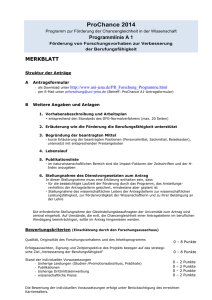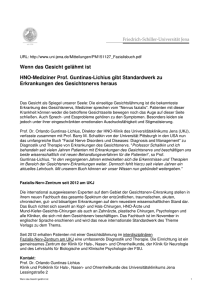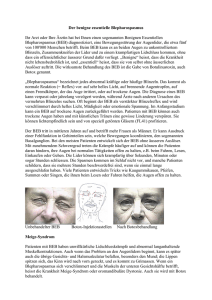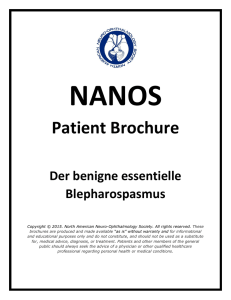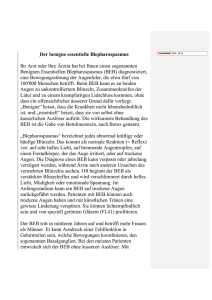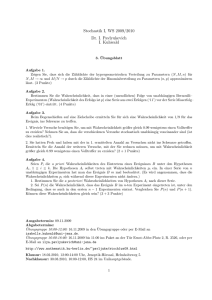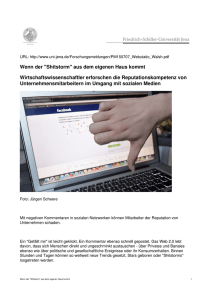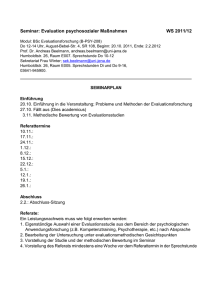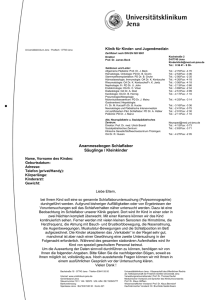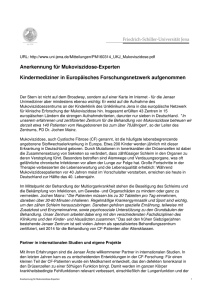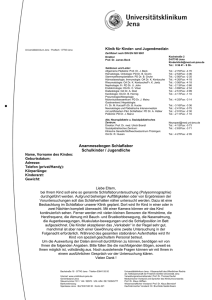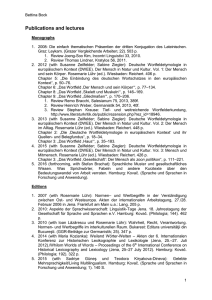Weitsprung
Werbung
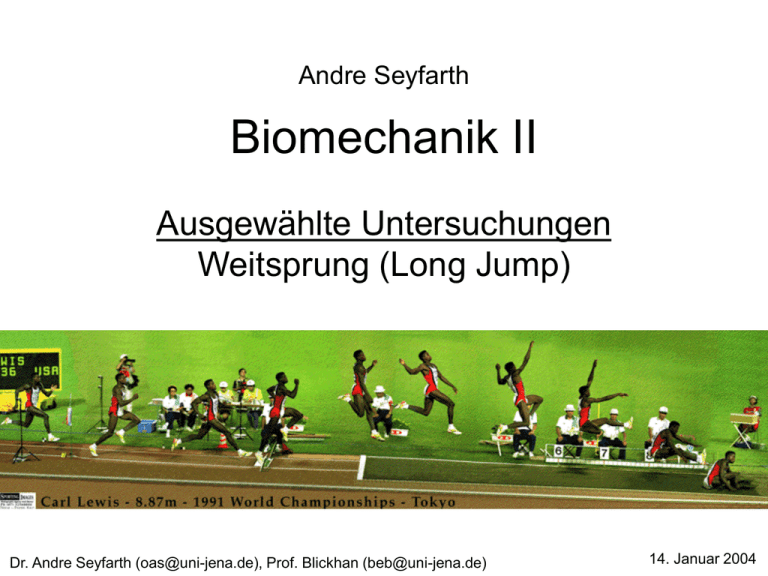
Andre Seyfarth Biomechanik II Ausgewählte Untersuchungen Weitsprung (Long Jump) Dr. Andre Seyfarth ([email protected]), Prof. Blickhan ([email protected]) 14. Januar 2004 Weitsprung (Long Jump) • Experimentelle Untersuchungen • Modellierung des Weitsprunges • Diskussion eines Artikels zum Weitsprung Dr. Andre Seyfarth ([email protected]), Prof. Blickhan ([email protected]) Teil 1: Weitsprung (Long Jump) • 4 Abschnitte: Anlauf – Absprung – Flugphase – Landung Dr. Andre Seyfarth ([email protected]), Prof. Blickhan ([email protected]) Teil 1: Weitsprung (Long Jump) Messtechnik • Videoanalyse 2D / 3D (>100Hz) • Kraftmessung, z.B. beim Absprung • Geschwindigkeitsmessung Lichtschrankenmessung 1, 6, 11 m vor Laveg • Elektromyographie Dr. Andre Seyfarth ([email protected]), Prof. Blickhan ([email protected]) Anlauf (Approach) Dr. Andre Seyfarth ([email protected]), Prof. Blickhan ([email protected]) Anlauf (Approach) Dr. Andre Seyfarth ([email protected]), Prof. Blickhan ([email protected]) Anlauf (Approach) Dr. Andre Seyfarth ([email protected]), Prof. Blickhan ([email protected]) Anlauf (Approach) Dr. Andre Seyfarth ([email protected]), Prof. Blickhan ([email protected]) Absprung: Bodenreaktionskräfte Rennen (Vorfuß- und Fersenlauf) Dr. Andre Seyfarth ([email protected]), Prof. Blickhan ([email protected]) Weitsprung (3-9 Schritte Anlauf) Absprung: Kinematik Dr. Andre Seyfarth ([email protected]), Prof. Blickhan ([email protected]) Beiträge zur Sprungweite Dr. Andre Seyfarth ([email protected]), Prof. Blickhan ([email protected]) Beiträge zur Sprungweite Dr. Andre Seyfarth ([email protected]), Prof. Blickhan ([email protected]) Einfluss der Anlaufgeschwindigkeit Dr. Andre Seyfarth ([email protected]), Prof. Blickhan ([email protected]) Warum springen Weitspringer nicht mit 45º ab? Dr. Andre Seyfarth ([email protected]), Prof. Blickhan ([email protected]) Modellierung des Weitsprunges hip joint m FPE FM d r FCE knee joint LEG ankle joint Dr. Andre Seyfarth ([email protected]), Prof. Blickhan ([email protected]) FSE Ergebnisse der Modellierung Dr. Andre Seyfarth ([email protected]), Prof. Blickhan ([email protected]) Woher stammt der erste Kraftstoß? Dr. Andre Seyfarth ([email protected]), Prof. Blickhan ([email protected]) Dynamik des Weitsprunges Woher stammt der erste Kraftstoß? Dr. Andre Seyfarth ([email protected]), Prof. Blickhan ([email protected]) Experimentelle Studie The EMG activity and mechanics of the running jump as a function of take-off angle W. Kakihana, S. Suzuki Journal of Electromyography and Kinesiology 11 (2001) 365-372. • Download: www.uni-jena.de/~oas/biomechanics2.html Dr. Andre Seyfarth ([email protected]), Prof. Blickhan ([email protected]) Experimentelle Studie Abstract Introduction Methods Results Discussion Dr. Andre Seyfarth ([email protected]), Prof. Blickhan ([email protected]) Zusammenfassung (Abstract) • 2 männliche Weitspringer TM und YS • Weitsprung mit unterschiedlicher Anlauflänge: 3-5-9 Schritte Dr. Andre Seyfarth ([email protected]), Prof. Blickhan ([email protected]) Proband TM im Vergleich zu YS – Kinematik • größere vertikale KSP-Geschwindigkeit beim Absprung bei allen Anlauflängen • Oberkörper mehr nach hinten gelehnt (bei Landung und Absprung) • Oberschenkel hat kleineren Bewegungsbereich • Knie und Sprunggelenk waren mehr gestreckt bei Landung • Knie mehr gebeugt beim Absprung Dr. Andre Seyfarth ([email protected]), Prof. Blickhan ([email protected]) Proband TM im Vergleich zu YS – Dynamik • • • • größerer Bremsstoß geringerer Beschleunigungsimpuls Hauptmuskeln: RF, VM, LG, TA BF nur kurz vor Beginn der Landung bis 2/3 des Bodenkontakts TM nutzt größeren Abflugwinkel, da er einen stärkeren Bremseffekt erzielte durch die Koordination der Muskeln um Hüfte, Knie und Sprunggelenk Dr. Andre Seyfarth ([email protected]), Prof. Blickhan ([email protected]) Introduction (Einführung) Koh&Hay 1990: Sprungweite ist mit (1) Landedistanz (r=0.44) sowie (2) der Änderung in der horizontalen Geschwindigkeit (r=-0.59) beim Absprung korreliert. Fuß beim letzten Schritt weit vor dem Körper aufsetzen unterstützt die Entwicklung der vertikalen Geschwindigkeit auf Kosten der horizontalen Geschwindigkeit. Dr. Andre Seyfarth ([email protected]), Prof. Blickhan ([email protected]) Dennoch individuelle Strategien, z.B. WM‘91 Mike Powell (8.95m) – 23.1° Abflugwinkel Carl Lewis (8.91m) – 18.3° Abflugwinkel Fukashiro et al.,1992 Kinematische Unterschiede: Oberkörperhaltung, Beinstreckung, Hüftrotation. Dr. Andre Seyfarth ([email protected]), Prof. Blickhan ([email protected]) Was ist der biomechanische Hintergrund für die unterschiedlichen Abflugwinkel? Dr. Andre Seyfarth ([email protected]), Prof. Blickhan ([email protected]) Frühere Studie von Kakihana et al., 1995: (1) höhere vertikale und geringere horizontale Abfluggeschwindigkeit durch: • geringere Aktivierung des BF • größere Bremsstöße (2) Erhalt der horizontalen Geschwindigkeit: • Aktivierung LG und Soleus • größerer Beschleunigungsimpuls Dr. Andre Seyfarth ([email protected]), Prof. Blickhan ([email protected]) Methoden (Methods) • 2 männliche Weitspringer TM (Bestweite 7.63m) und YS (Bestweite 6.80m) • Weitsprung mit unterschiedlicher Anlauflänge: 3-5-9 Schritte, 2-4 mal hintereinander, Indoor, Landung auf der Matte (anstatt Sand) • Kraftplattform (KISTLER, 9281B) und Anlaufstrecke mit Gummimatten ausgelegt. • Sprungweite gemessen von den Zehen beim Abflug bis zu der Ferse bei der Landung Dr. Andre Seyfarth ([email protected]), Prof. Blickhan ([email protected]) Methoden (Methods) • Kräfte vertikal Fz, nach vorne Fy, seitwärts Fx sowie Kraftangriffspunkt, Abtastfrequenz 1000Hz • Marker (2cm groß) an charakteristischen Körperstellen: 5. Metatarsalgelenk, Sprunggelenk, Knie, Huefte, Handgelenk, Ellenbogen, Schulter, am Kopf, Nacken • High-Speed Kamera HSV500, NAC mit 250Bildern/s Aufnahmefrequenz Dr. Andre Seyfarth ([email protected]), Prof. Blickhan ([email protected]) Methoden (Methods) KSP Berechnung basierend auf 15 Körpersegmenten nach Miura et al., 1974. 11m Synchronisation! Markerkoordinaten Tiefpass Filter Butterworth 12 Hz Berechnung der Gelenkwinkel und Winkelgeschwindigkeiten Dr. Andre Seyfarth ([email protected]), Prof. Blickhan ([email protected]) Methoden (Methods) • Bipolares S-EMG von BF, VM, RF, LG, TA, Sol • Elektrodenpaar je im Abstand von 3 cm geklebt und mit Klebeband fixiert • telemetrische Übertragung • Bandpass 15-250Hz • EMG Gleichgerichtet und geglättet. • Aufnahmefrequenz 1000Hz Dr. Andre Seyfarth ([email protected]), Prof. Blickhan ([email protected]) RF VM BF LG Sol TA Ergebnisse (Results) Dr. Andre Seyfarth ([email protected]), Prof. Blickhan ([email protected]) Ergebnisse (Results) Dr. Andre Seyfarth ([email protected]), Prof. Blickhan ([email protected]) Dr. Andre Seyfarth ([email protected]), Prof. Blickhan ([email protected]) Dr. Andre Seyfarth ([email protected]), Prof. Blickhan ([email protected]) Dr. Andre Seyfarth ([email protected]), Prof. Blickhan ([email protected]) RF VM LG Sol TA Dr. Andre Seyfarth ([email protected]), Prof. Blickhan ([email protected]) Diskussion • TM höhere vertikale KSP-Geschwindigkeit beim Abflug als YS • Gleichzeitig Oberkörper mehr nach hinten gelehnt, Bein mehr gestreckt TM größerer Bremseffekt, weniger Vortrieb als YS Hay 1986: Rücklage des Oberkörpers sowie gestrecktes Absprungbein beeinflusst signifikant die Sprungweite Dr. Andre Seyfarth ([email protected]), Prof. Blickhan ([email protected]) Diskussion • EMG Koaktivität von RF und VM bei TM von kurz vor Kontakt bis 2/3 des Kontakts RF und VM sind Synergisten als Knieextensoren bremsen Kniebeugung unter Körperlast • EMG Aktivität von BF bei TM nur moderat, bei YS ähnlich wie beim Gehen oder Rennen • Koaktivierung von TA und LG bei TM (=hohe Gelenksteifigkeit), jedoch reziproke Aktivierung bei YS Dr. Andre Seyfarth ([email protected]), Prof. Blickhan ([email protected]) Abfluggeschwindigkeit v konstant v nicht konstant vY vY 45° optimal Optimaler Winkel Energieverluste vX Dr. Andre Seyfarth ([email protected]), Prof. Blickhan ([email protected]) vX Vielen Dank für die Aufmerksamkeit! Dr. Andre Seyfarth ([email protected]), Prof. Blickhan ([email protected])
